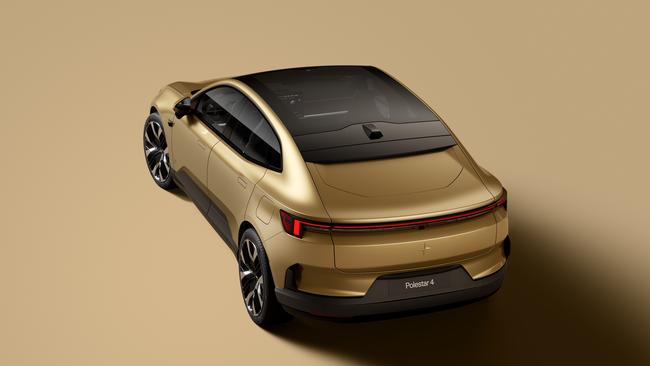Polestar 4 deletes the rear window
The Polestar 4 has done away with the rear glass altogether, replacing it with a panel and making it look like a motor show concept car that has somehow snuck out onto public roads.

Is the rear window set to go the way of the CD player, the cigarette lighter and, soon enough, the combustion engine? Polestar, the Swedish-Chinese EV company that’s about to pour forth an attractive slew of new offerings this year, seems to think so.
The Polestar 4, which looks like an SUV that really wishes it was a coupe, has done away with the rear glass altogether, replacing it with a panel that gives it a striking rear end and only adds to the sense that this is that rare thing, a motor show concept car that has somehow snuck out onto public roads.
The new EV, set to arrive in Australia in August, priced from $81,500, deals with the obvious practical issue by using a camera in the rear bumper to feed a digital rear-vision mirror, which provides a high-definition, and extra wide, view of the world behind the driver. Thankfully, the car still has conventional wing mirrors.
The reasoning behind the deletion of the rear window is not merely stylistic, although you can bet that’s part of it; Polestar describes itself as a “design-led company”. Its justification for the unprecedented move is that the removal of the rear glass panel not only allows a lovely, coupe-style roof line but allows the car’s vast glass roof (the kind that seems to come with most EVs these days) to extend past the rear passengers’ heads, thus providing more headroom for actual, full-sized humans to sit in the back.
In technical terms, the change has allowed the designers to move the structural crossbars of the roof further back, behind the rear passengers.
The Australian is yet to drive the Polestar 4 but on a recent visit to Sweden we did manage to sneak into the back seat of one to satisfy our curiosity about how it would look and feel. There is a surprising amount of rear headroom for such a coupe-style vehicle, although describing it, as Polestar does, as a “mid-sized SUV” still seems strange, because it looks and feels more like a sports car, with touches of Porsche and even Ferrari about the front-end styling.

Rear passengers also gain a real sense of spaciousness from the amount of glass above and in front of them, although it is undeniably strange to turn around and see only panelling rather than a window behind you. The most analogous vehicle would actually be one of those vast stretch limousines where the glass is so thoroughly blacked out, it feels non-existent.
While Polestar already has a clear competitor for the Tesla Model 3 in the stylish sedan shape of the Polestar 2, it will soon be joined by an attractive large SUV, the Polestar 3 (look out for our review of driving that one on a frozen lake in Lapland in The Weekend Australian Magazine soon) and the Polestar 4, which will be available with either a single-motor, rear-wheel-drive layout or a dual-motor, all-wheel-drive variant. Claimed driving range for Polestar 4 is 610km, while the Long Range Dual Motor version offers 400kW and 686Nm, enough for a zero to 100km/h sprint of just 3.8 seconds.
While the entry-level price seems very low for such an attractive machine, that’s very much a base variant and the addition of an extra motor and some option packs will quickly push the price north of $100,000.




